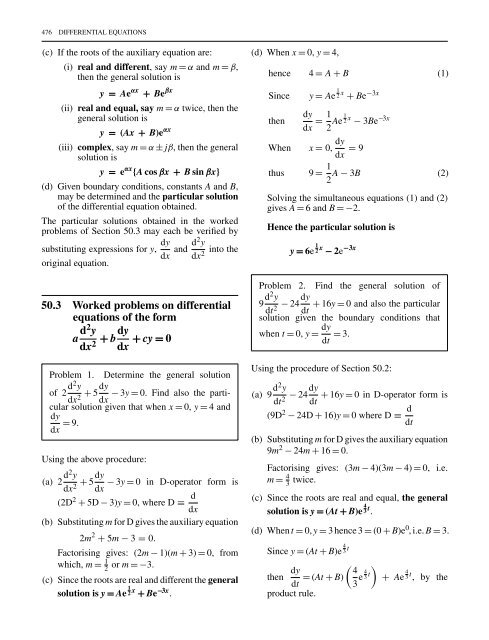differential equation
You also want an ePaper? Increase the reach of your titles
YUMPU automatically turns print PDFs into web optimized ePapers that Google loves.
476 DIFFERENTIAL EQUATIONS<br />
(c) If the roots of the auxiliary <strong>equation</strong> are:<br />
(i) real and different, say m = α and m = β,<br />
then the general solution is<br />
y = Ae αx + Be βx<br />
(ii) real and equal, say m = α twice, then the<br />
general solution is<br />
y = (Ax + B)e αx<br />
(iii) complex, say m = α ± jβ, then the general<br />
solution is<br />
y = e αx {A cos βx + B sin βx}<br />
(d) Given boundary conditions, constants A and B,<br />
may be determined and the particular solution<br />
of the <strong>differential</strong> <strong>equation</strong> obtained.<br />
The particular solutions obtained in the worked<br />
problems of Section 50.3 may each be verified by<br />
substituting expressions for y, dy<br />
dx and d2 y<br />
into the<br />
dx2 original <strong>equation</strong>.<br />
50.3 Worked problems on <strong>differential</strong><br />
<strong>equation</strong>s of the form<br />
a d2 y<br />
dx 2 + bdy dx + cy = 0<br />
Problem 1. Determine the general solution<br />
of 2 d2 y<br />
dx 2 + 5dy − 3y = 0. Find also the particular<br />
solution given that when x = 0, y = 4 and<br />
dx<br />
dy<br />
dx = 9.<br />
Using the above procedure:<br />
(a) 2 d2 y<br />
dx 2 + 5dy − 3y = 0 in D-operator form is<br />
dx<br />
(2D 2 + 5D − 3)y = 0, where D ≡ d dx<br />
(b) Substituting m for D gives the auxiliary <strong>equation</strong><br />
2m 2 + 5m − 3 = 0.<br />
Factorising gives: (2m − 1)(m + 3) = 0, from<br />
which, m =<br />
2 1 or m =−3.<br />
(c) Since the roots are real and different the general<br />
solution is y = Ae 2 1 x + Be −3x .<br />
(d) When x = 0, y = 4,<br />
hence 4 = A + B (1)<br />
Since<br />
then<br />
When<br />
y = Ae 1 2 x + Be −3x<br />
dy<br />
dx = 1 2 Ae 1 2 x − 3Be −3x<br />
x = 0, dy<br />
dx = 9<br />
thus 9 = 1 A − 3B (2)<br />
2<br />
Solving the simultaneous <strong>equation</strong>s (1) and (2)<br />
gives A = 6 and B =−2.<br />
Hence the particular solution is<br />
y = 6e 1 2 x − 2e −3x<br />
Problem 2. Find the general solution of<br />
9 d2 y<br />
dt 2 − 24dy + 16y = 0 and also the particular<br />
dt<br />
solution given the boundary conditions that<br />
when t = 0, y = dy<br />
dt = 3.<br />
Using the procedure of Section 50.2:<br />
(a) 9 d2 y<br />
dt 2 − 24dy + 16y = 0 in D-operator form is<br />
dt<br />
(9D 2 − 24D + 16)y = 0 where D ≡ d dt<br />
(b) Substituting m for D gives the auxiliary <strong>equation</strong><br />
9m 2 − 24m + 16 = 0.<br />
Factorising gives: (3m − 4)(3m − 4) = 0, i.e.<br />
m = 4 3 twice.<br />
(c) Since the roots are real and equal, the general<br />
solution is y = (At + B)e 4 3 t .<br />
(d) When t = 0, y = 3 hence 3 = (0 + B)e 0 , i.e. B = 3.<br />
Since y = (At + B)e 4 3 t<br />
then dy ( ) 4<br />
dt = (At + B) 3 e 4 3 t + Ae 4 3 t , by the<br />
product rule.










